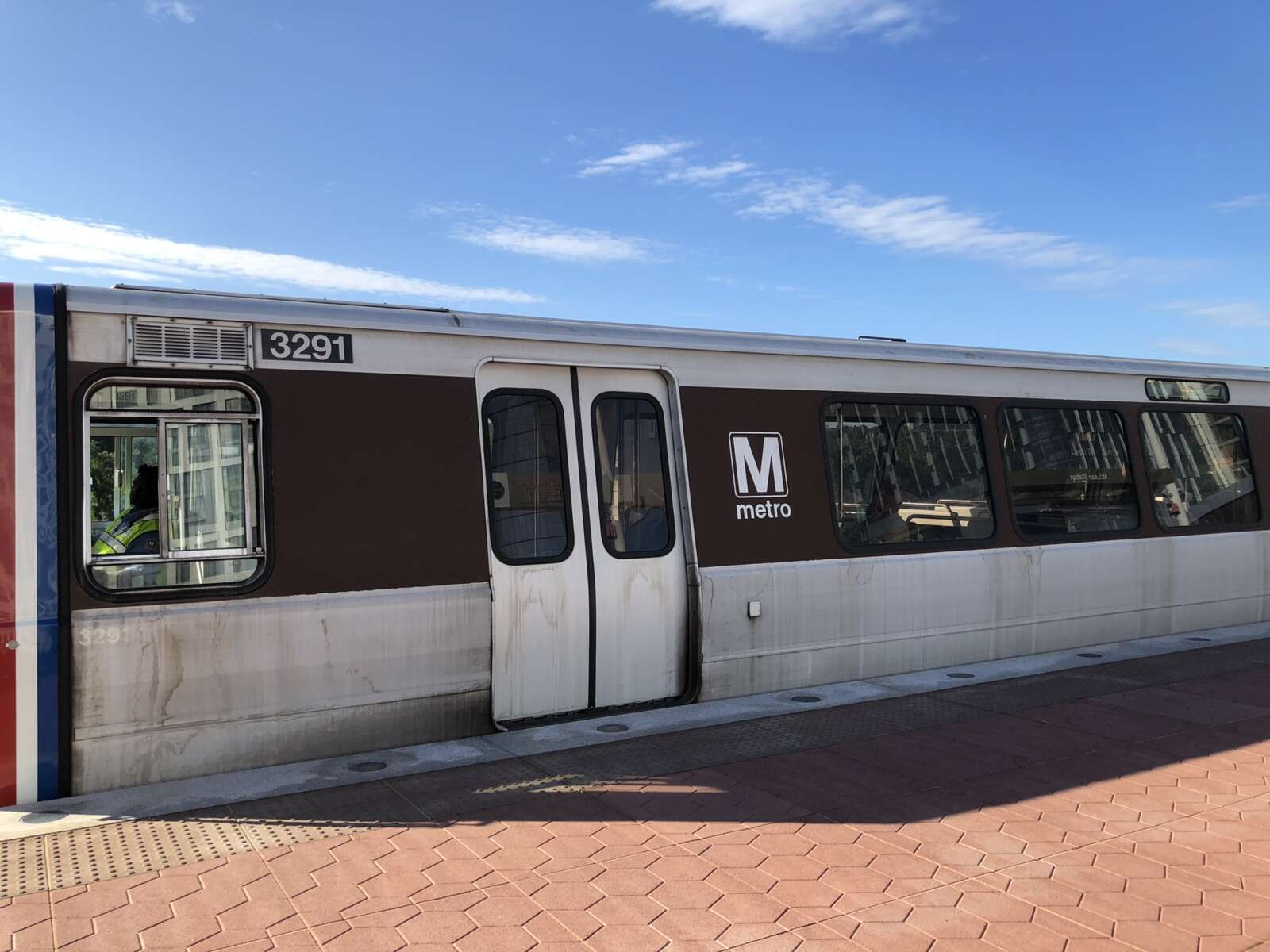
The Fairfax County Board of Supervisors is asking the county’s General Assembly delegation to oppose Gov. Glenn Youngkin’s proposed funding cuts to Metro in the state’s budget.
During a board meeting on Tuesday (April 16), supervisors unanimously approved a letter written by Chairman Jeff McKay, Braddock District Supervisor James Walkinshaw, and Dranesville District Supervisor James Bierman, asking the delegation to oppose the cuts and retain the funding needed to address the Washington Metropolitan Area Transit Authority’s (WMATA) estimated $750 million shortfall.
The General Assembly passed the FY 2024-2026 biennium budget in March which included $149.5 million from the state to address WMATA’s funding shortage in FY 2025 and FY 2026, according to the letter.
“This funding, which is expected to be matched by the local funding partners, including Fairfax County, is essential to putting WMATA on sound financial footing and retaining its consistent operations.”
A month later, Youngkin announced his proposed budget amendments, which included cutting $113.8 million of WMATA’s funding. Instead, Youngkin urged localities to use funds previously allocated to them through state assistance.
However, the county clarified in its letter that this money — provided to the region through the Northern Virginia Transportation Commission (NVTC) by the Northam Administration in 2022 — was used to cover immediate Metro payments following the pandemic and to reserve the remainder for “ongoing needs.”
Even with the additional funding, the letter says the county expects the money from the NVTC to be largely depleted soon, making their request even more vital.
“We know WMATA is absolutely essential to our regional economy,” McKay said during Tuesday’s County Board meeting. “It is essential to Virginia’s economy, bringing in over $1 billion a year into the general fund.”
He also noted how the lack of funding could impact taxpayers.
“If this money doesn’t come from the state, where will it come from? From the real estate taxpayers of Fairfax County. That’s where it will come from,” McKay said.
Springfield District Supervisor Pat Herrity said he was reluctantly supporting the request, saying Metro needed to “figure out how they’re going to get their costs under control.”
“We’ve got to get the long-term answer figured out because, you know, punting it down the road with a couple more years of ridiculous funding increases is not necessarily the best answer,” Herrity said.
Citing a 2017 study by former U.S. Department of Transportation Secretary Ray LaHood, Walkinshaw noted that Metro would need $500 million a year in dedicated funding to achieve stable financial footing, a burden that would ultimately fall on resident taxpayers.
“This idea that there are hundreds of millions of dollars or billions of dollars of cost savings to be found at Metro is a fantasy,” he said. “The amount needed in dedicated funding to prevent us from having to go back to property taxpayers every single year is in the hundreds of millions of dollars. That’s just math.”
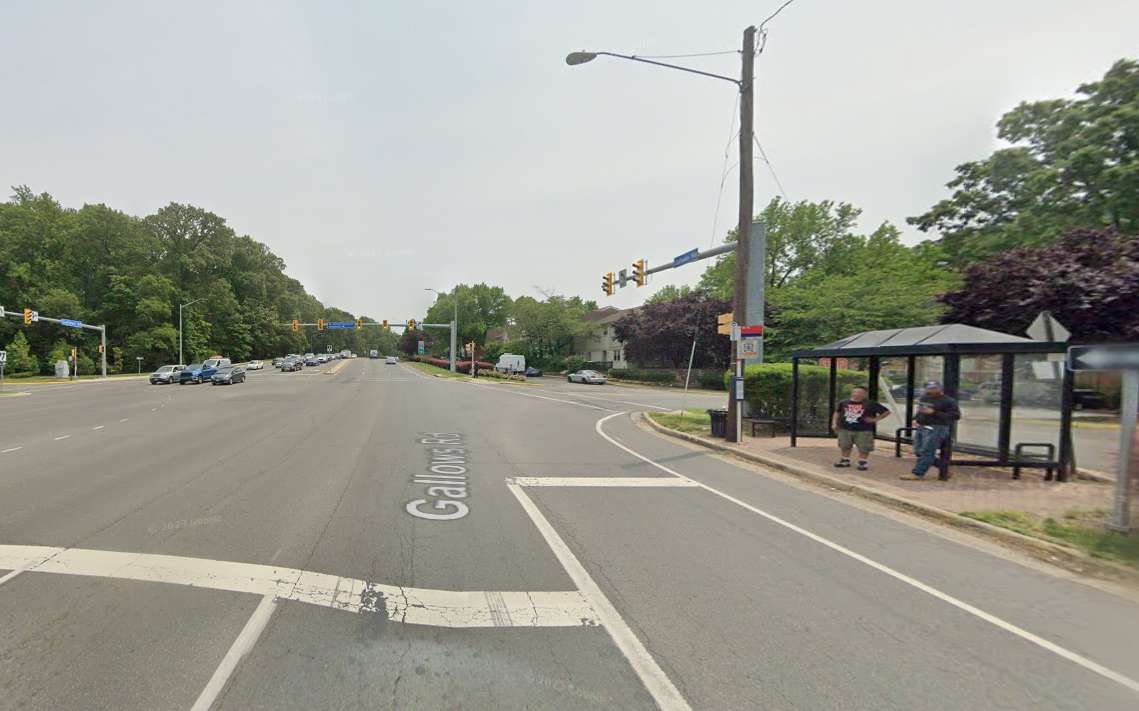
(Updated at 11:20 a.m.) A boy was taken to the hospital yesterday (Sunday) after a crash near Inova Fairfax Hospital.
The Fairfax County Police Department reported at 6:32 p.m. that officers were on scene of a crash involving a sedan and a bus on Gallows Road at Anderson Road in Merrifield.
A passenger in the sedan, the boy was hospitalized with injuries initially considered life-threatening. His condition is no longer believed to be critical.
“The juvenile remains hospitalized, and his condition has been upgraded to non-life-threatening injuries,” the FCPD said this morning (Monday).
According to police, the bus in the crash was a Metrobus.
“There were passengers on the bus but there were no reported injuries to passengers on the Metrobus,” an FCPD spokesperson said.
A spokesperson for the Washington Metropolitan Area Transit Authority suggested FFXnow reach out to the FCPD when contacted for comment, noting that the police department is the lead in traffic investigations.
One lane of Gallows Road was closed last night while Crash Reconstruction Unit detectives investigated, but it reopened around 9:18 p.m.
Officers are on scene of a two-vehicle crash involving a bus and a sedan at Gallows Rd & Anderson Dr in Merrifield. A juvenile occupant in the sedan was taken to hospital w/injuries considered life threatening. (1/2) pic.twitter.com/knTR2v1biO
— Fairfax County Police (@FairfaxCountyPD) March 3, 2024
Image via Google Maps

Local and state officials in Virginia say the path to dig Metro out of its looming $750 million deficit is uncertain — but action is necessary to avoid the significant service cuts, systemwide fare hikes, layoffs and station closures laid out in the transit agency’s newly proposed budget.
Leaders in Fairfax County — which already faces lean economic times — say they don’t plan to offer up additional funds unless jurisdictional and federal partners can throw some more skin into the game.
“What we have said is there’s absolutely no way that local governments can bear the responsibility of that entire bill,” Fairfax County Board of Supervisors Chairman Jeff McKay told FFXnow in an interview before the Washington Metropolitan Area Transit Authority released its official budget proposal.
WMATA has been sounding the alarm on its projected budget shortfall since June.
“What I think you’re going to see happen is there’s going to be some matching and some partnerships,” McKay said.
In a first glimpse of the proposed budget, which was released last Tuesday (Dec. 12), Metro General Manager Randy Clarke laid out what would happen if Metro can’t secure local, state and federal funds to address a problem that has been coalescing for years.
“Metro is facing an unprecedented, existential crisis that requires our region to rally together if we want to avoid the catastrophic impacts this budget would have on our region,” he said.
The system would close at 10 p.m. every day and shutter 10 low-ridership stations. Silver Line trains would turn back at Stadium-Armory, with trains running between Ashburn and that station. Similar reduced turn-backs would take place on the Red Line.
Trains would run every 15 minutes for most stations — a 17 to 67% increase in wait-times across the board on weekdays — and every 20 minutes on weekends for most stations — a 40 to 70% increase. Fares would also jump by 20%.
Among other cuts and more than 2,000 layoffs, Metro would use $193 million from its capital funds to cover operating maintenance expenses — essentially borrowing against the future.
“Such a large transfer of capital funds to operating expenses puts the system’s state of good repair, including safety and reliability, at risk, and threatens to delay, defer, decrease, or cancel several long-term projects to modernize the system,” WMATA cautioned in a press release.
But it’s unclear when and if local and state bodies will offer up enough funding. The subsidized system relies on annual subsidies from Maryland, Virginia and D.C., as well as fare revenue and federal dollars. The fiscal year 2025 budget begins July 1, 2024.
Metro needs subsidy increases of $180 million from Virginia, which has already allocated $348 million. Similar increases are sought from other jurisdictions. The upcoming General Assembly session will determine how much the state is willing to put down to assuage the bleeding after federal COVID-19 funding ends for the system. Read More
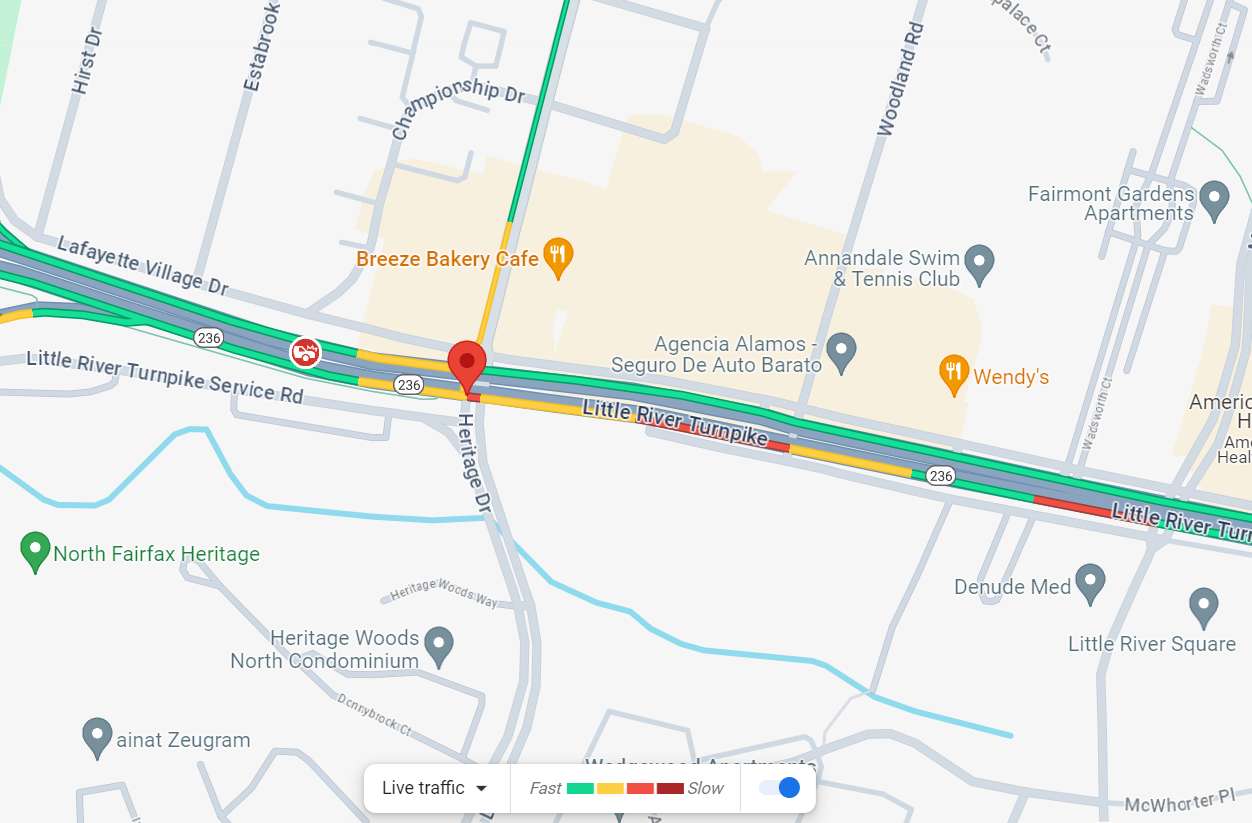
A woman suffered serious injuries earlier this evening (Monday) when she was apparently hit by a Metrobus on Little River Turnpike.
“Officers are investigating a bus crash involving a pedestrian that occurred on Little River [Turnpike] and Hummer [Road] in Annandale,” the Fairfax County Police Department said. “The pedestrian, an adult female, was transported in life-threatening condition.”
Eastbound Little River Turnpike was shut down at Hummer.
First responders were dispatched to that intersection for the crash just before 10 p.m., according to scanner traffic on Open MHz. When police and Fairfax County Fire and Rescue Department units arrived, the woman was found trapped under the front wheels of the bus.
“It does look like we’ve got one patient with severe head wounds. She is alert and conscious right now,” an FCFRD responder said at 10:04 p.m.
The fire department responder in command reported at 10:10 p.m. that the trapped woman was a pedestrian and the vehicle was a Metrobus.
Metro didn’t immediately respond to a request for comment.
The woman was transported to Inova Fairfax Hospital with serious injuries. No passengers were on the bus, per the scanner.
Officers are investigating a bus crash involving a pedestrian that occurred on Little River Trpk and Hummer Rd in Annandale. The pedestrian, an adult female, was transported in life-threatening condition. EB Little River Trpk is closed at Hummer Rd. Please avoid the area #FCPD pic.twitter.com/QSivOK6VHa
— Fairfax County Police (@FairfaxCountyPD) December 5, 2023
WOMAN RUNOVER AND TRAPPED UNDER METROBUS— Little River Turnpike at Hummer Rd in Annandale. She was last reported conscious but with a severe head injury. She is under the front axle. Heavy-duty wreckers req'd to assist with rescue. #VATraffic #WMATA @MetroGuns pic.twitter.com/FwrdV2VczQ
— Alan Henney (@alanhenney) December 5, 2023
Map via Google Maps

(Updated at noon) Trains are taking off at the Dulles Airport Metro station one year after the opening of Phase Two of the Silver Line — but ridership at the other five stations of the $3 million project has a long way to catch up.
In the backdrop of post-pandemic recovery, ridership for stations beyond the airport is modest, according to Metro data.
More than 3.5 million trips later, daily average ridership on the rail extension hovers at 3,600 trips. Metropolitan Washington Airport Authority (MWAA) planners had hoped for 20,000 riders a day when the rail line was being planned in the early 2000s.
But that was well before the pandemic upended how people work and travel, among other societal trends.
Jordan Pascale, a spokesperson for the Washington Metropolitan Area Transit Authority (WMATA), emphasized that “many factors have changed since then,” especially the massive shift to telework that has contributed to reduced revenue and a $750 million budget shortfall.
As more companies usher — and, in some cases, threaten — their employees to return to long-empty offices, Pascale notes that the Metro system has recovered more than half of the riders it lost at the onset of the pandemic.
“Our ridership has continually increased, but recovered unevenly with strong ridership on weekends, Tuesdays, Wednesdays, and Thursdays,” Pascale said.
One year ago today, the long-anticipated Silver Line Extension opened six new stations in Northern Virginia. They've now seen 3.5 million trips!
The extension took a lot of work, and I'm thrilled to see so many Virginians making good use of it every single day. https://t.co/FWFdfaDU1p
— Rep. Gerry Connolly (@GerryConnolly) November 15, 2023
While Dulles Airport boasts more than 1.2 million cumulative entries, the stations in Herndon and Reston hover in the mid-to-high 400,000s.
Herndon has had more than 482,000 entries since service began last November, compared to 431,000 at Innovation Center and 450,356 at Reston Town Center. Ashburn has the second highest ridership figures (774,000), while Loudoun Gateway — which is on the west end of the rail — stood at 156,000, as of Nov. 12.
“The biggest wins are probably the new connectivity with Dulles Airport and across the Dulles Corridor,” said Hunter Mill District Supervisor Walter Alcorn, who represents Reston. “The rail line provides convenient options for airport passengers and workers, and for many who live and work in the Dulles Corridor. It has also reduced the number of vehicles driving to and parking in the commuter garage at the Wiehle Reston-East station.” Read More
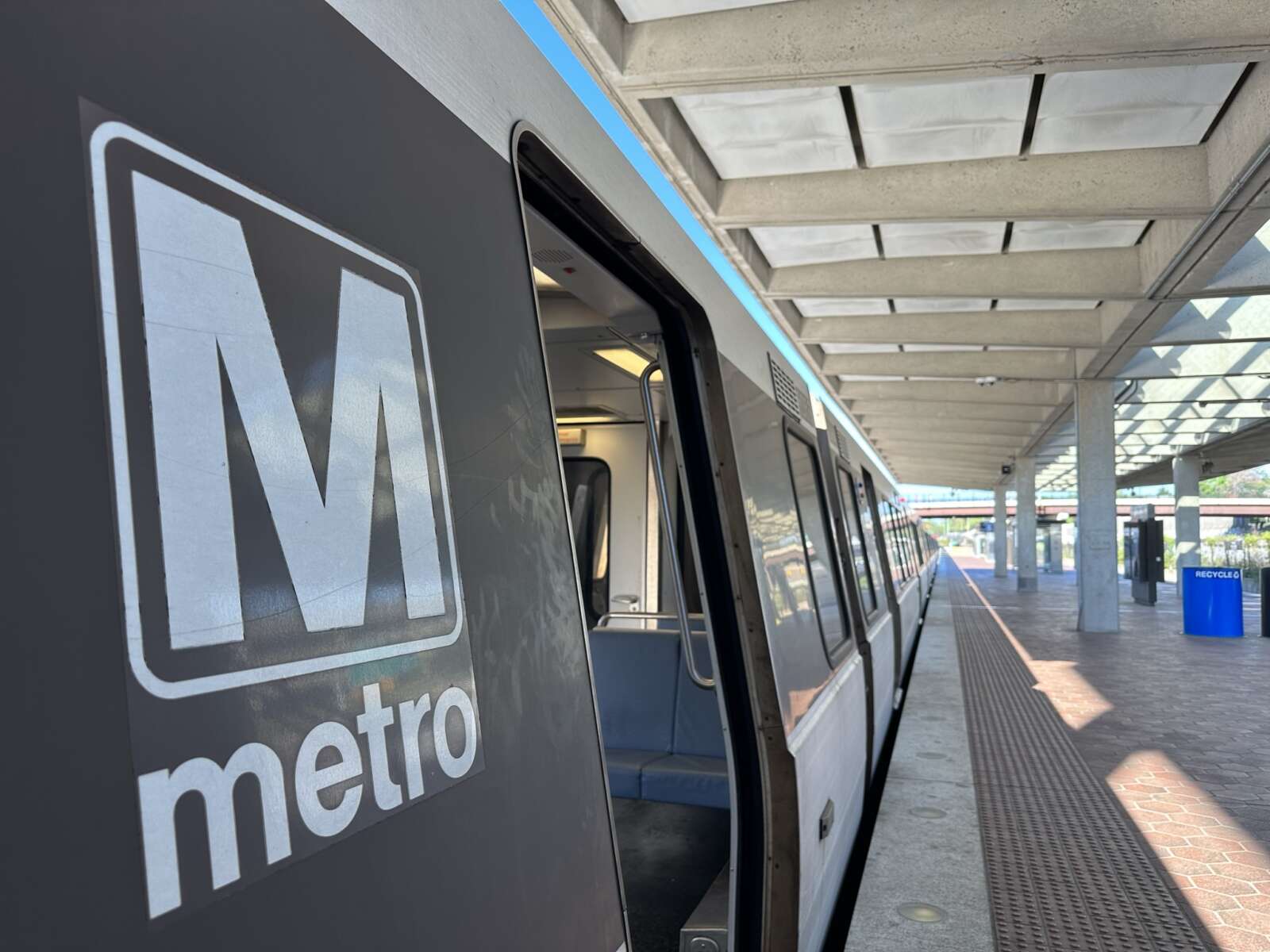
As Metro considers ways to address a looming $750 million shortfall and stave off changes to its operations, officials are requesting jurisdictions, including Virginia, review their options to help address the funding deficit that threatens thousands of jobs and various services.
Metro hopes policymakers in the commonwealth will consider adjusting the state law that sets a 3% cap on the growth of Virginia’s annual payment to the Washington Metropolitan Area Transit Authority. Dedicating more funding to Metro and overlooking the demands of other transportation projects, however, concerns some lawmakers and transportation leaders.
The shortfall
[Earlier this month], Metro officials made their case to Virginia leaders at the Commonwealth Transportation Board’s work session and joint House and Senate Transportation meeting in Arlington.
“We are obviously trying to avoid the cuts, but to do that, we need the cap [readjusted] and the certainty around funding,” said Randy Clarke, general manager and CEO of Metro, speaking at the Oct. 17 CTB work session.
As the agency faces a loss of COVID-19 relief funding at the end of the fiscal year, Metro officials said the reasons for the expected shortfall include revenue decreases since the COVID-19 pandemic, contractual commitments such as bargaining agreements and increased inflation costs.
In the meantime, Metro is focused on belt-tightening to avoid potential layoffs of about 5,000 employees, hiring freezes, and service cuts; the agency is also considering fare increases. Clarke said Metro is closely managing its operating expenses to help with carryover to the next fiscal year, and it could have a recurring fund of $50 million every year going forward for the next 10 years as part of an earlier initiative to create a savings plan.
“We’ve significantly reduced the …deficit for this year, but some of these are one-year solutions, but I think everyone again is just trying to figure out a more holistic path forward,” Clarke said.
On Oct. 19, Virginia Secretary of Transportation Shep Miller told the Mercury at the Governor’s Transportation Conference that region and state transportation leaders are considering Metro’s proposed shortfall. However, after speaking with committee members, it’s unclear which body will take up Metro’s request.
At the Oct. 17 work session, Miller said Metro is an important system and has been on “good footing” compared to previous years marked by management issues. Still, the agreement between the jurisdictions, and the millions of dollars each is being asked to contribute to Metro, is a difficult matter.
“Whether the number is 750 or whether it’s 500, or whether it’s 350, on an annual basis, [it] is going to be a choker for the folks that got to come up with the money,” Miller said.
3% cap
Clarke said Metro needs some clarity on what funding adjustments Virginia can make to address the expected deficit, ideally by December. To help address the $750 million shortfall, Metro officials are proposing Maryland and Virginia adjust their 3% cap on the growth of their annual payments to WMATA, which would require a one-time adjustment for fiscal year 2025.
However, in Virginia, any changes to the state law could be a lengthy process.
“Virginia, Maryland and the District all have different calendars and the timing and some of the things that the general manager and his team will have to enact or put in place [makes for] a very complicated situation that we’ll have to work through,” said Paul Smedberg, chair of the Metro Board of Directors. Read More
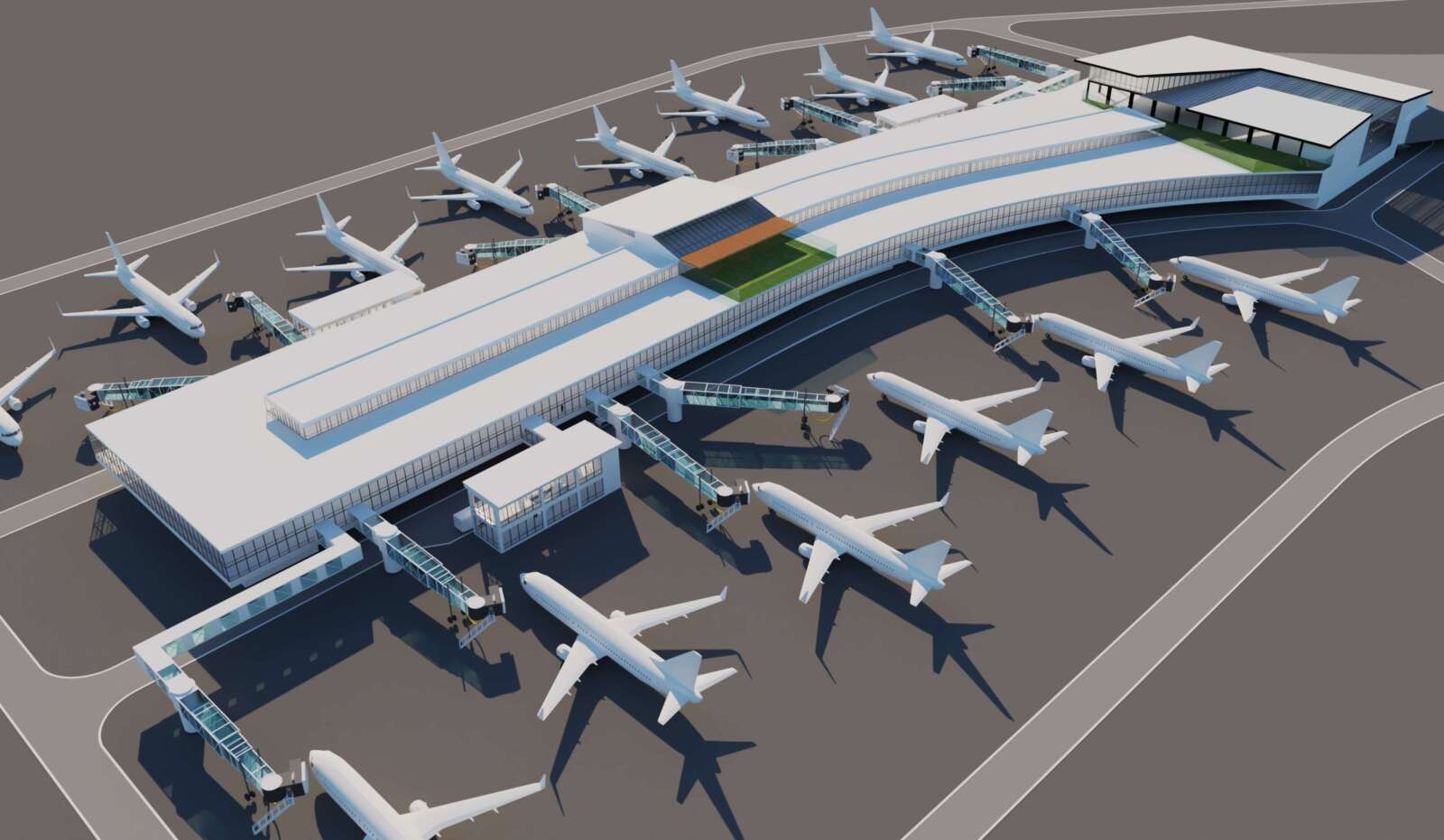
United Airlines is in line for a major expansion of its facilities at Dulles International Airport.
Construction on a new concourse for the airport’s largest carrier could break ground within the next month, Metropolitan Washington Airports Authority President and CEO Jack Potter told the Fairfax County Board of Supervisors at a Tuesday (Oct. 17) transportation committee meeting.
Dubbed Tier-2 Concourse East, the $580 million project will add 400,000 square feet on top of the existing C and D concourse, replacing Concourse A gates built in the 1990s that require passengers to use outdoor, covered walkways to get to their planes.
Expected to become operational in 2026, the new concourse will have 14 gates, seven of them capable of accommodating larger planes for international flights. It will also directly connect to the airport’s underground Aerotrain system, which is currently only accessible from the C/D concourse by a pedestrian walkway that “people find that very inconvenient,” Potter said.
“I think it’s going to significantly improve the customer experience,” Potter said, noting that the C/D concourse has undersized rooms and lacks sufficient space for concessions. “That’s the two things we’re trying to drive on: we want capacity, but we also want to really make sure that we improve the customer experience.”
Work on the concourse project is kicking into gear as Dulles Airport and Reagan National Airport fully recover from the COVID-19 pandemic, combining for 4.6 million passengers in August to surpass 2019 levels, according to Potter’s presentation to the transportation committee.
While that demand was initially driven by National Airport in Arlington, a resurgence of international travel has now pushed Dulles ahead of its more constrained counterpart in terms of growth, Potter said.
Dulles is serving more passengers from Latin America, Africa, the Middle East and Europe than it was before the pandemic, and domestic travel has returned to 97% of 2019 levels, according to MWAA. The only region significantly lagging is Asia, which Potter attributed to “the geopolitical situation” in China.
Metro’s extension of the Silver Line through Dulles Airport has been a “win-win” for MWAA and Fairfax County, Potter said, as the accompanying influx of development and businesses along the Dulles corridor feeds traffic at both of the D.C. area’s major airports.
In addition to giving fliers a new travel option, the station has expanded MWAA’s reach when it comes to recruiting employees, who get incentives for using transit, Potter told the committee. The Dulles station hit 1 million passengers on Oct. 4 — accounting for a third of the over 3 million people who have used the six new Silver Line stations since they opened last Nov. 15.
“We are selling very, very strongly to international destinations and travelers that they can come into Dulles Airport and take transit to downtown [D.C.] and any other destination served by the Metro,” Potter said. “It is a very, very good selling point.”
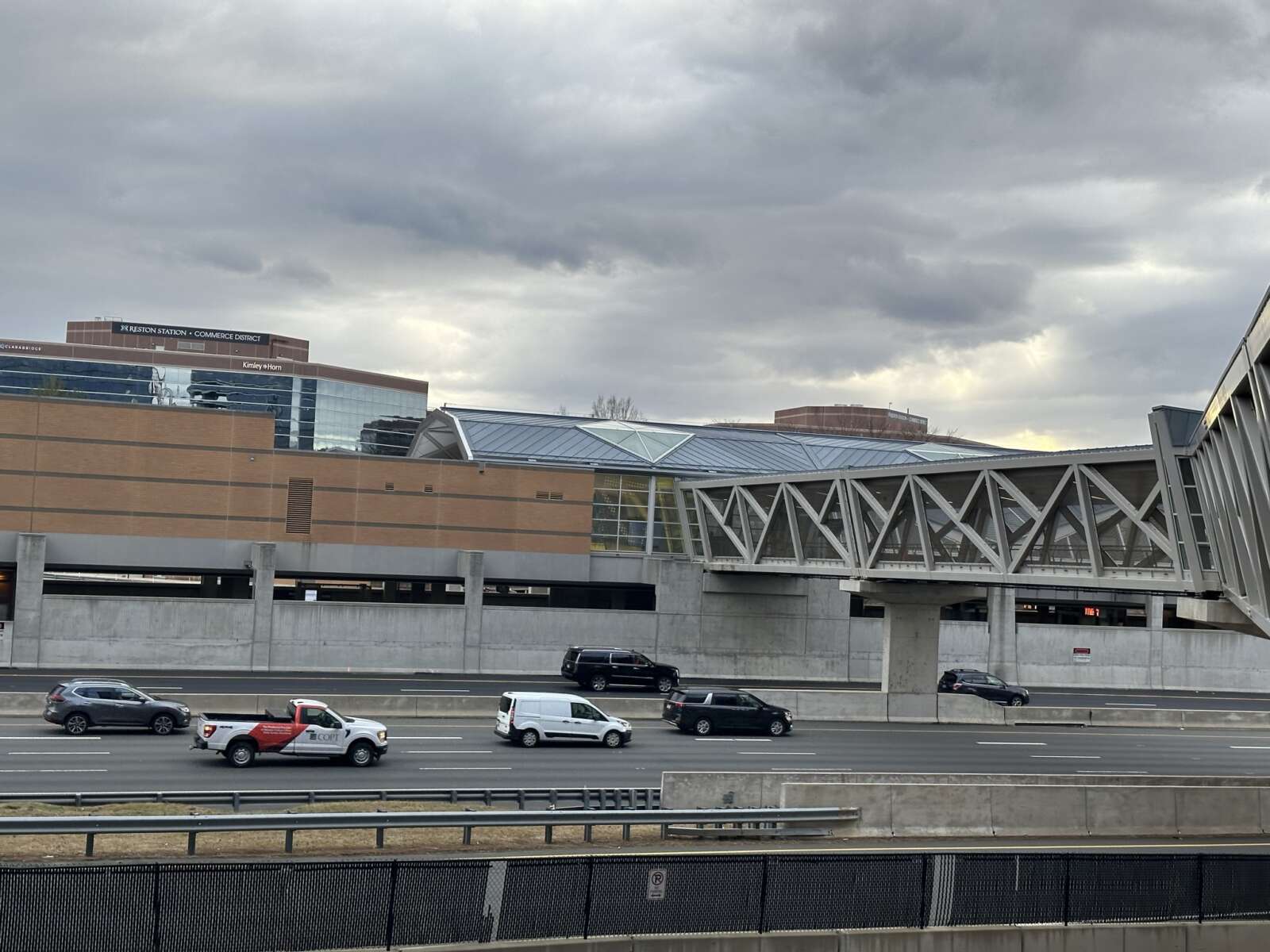
Reston Association’s Board of Directors has formally come out in opposition to the possibility of a casino near the Wiehle-Reston East Metro station.
In a statement released yesterday (Monday), RA CEO Mac Cummins lamented what he said was lack of communication with RA’s leadership, board and members regarding potential state legislation that would add Fairfax County to the list of Virginia localities authorized to have a casino.
“We strongly believe that a casino in our community, surrounded by natural areas including lakes, tree canopy and natural trails valued by our residents, would be detrimental to the property values of our homes and inconsistent with our values as a community,” Cummins wrote in a statement.
Reston-based developer Comstock has shown interest in building a casino near the Metro Station, Reston Patch reported last week.
First, the General Assembly must approve state-enabling legislation. Then, county voters would participate in a referendum on whether a casino should be allowed.
The necessary bills were first introduced — and quickly withdrawn — by state Sen. Dave Marsden (D-37) and Del. Wren Williams (R-9) this past January, as the Washington Business Journal reported. It specified that the casino should be located within one quarter-mile of a Silver Line Metro station, part of a mixed-used development, outside the Dulles airport flight path and outside the I-495 Beltway.
In a letter to Marsden, who plans to re-introduce the bill next year if he’s reelected, RA board president John Farrell expressed disappointment and shock.
“Reston has just finished a 4-year citizen-led effort to update our Master Plan. The Fairfax Board of Supervisors adopted that Comprehensive Plan Amendment on September 12, 2023,” he wrote. “Nowhere in that plan is a casino contemplated for Reston.”
Hunter Mill District Supervisor Walter Alcorn has also publicly stated that he opposes the establishment of a casino in Reston.
Virginia currently only allows casino gambling in five cities. The proposed amendment from Marsden and Williams would’ve expanded that to any locality with over 1 million residents and a county executive form of government — criteria matched only by Fairfax County.
The faregates at the Vienna Metro station are sporting a new look.
Workers installed taller doors on the gates on Aug. 9 as part of a systemwide retrofit project intended to combat fare evasion, which costs Metro an estimated $40 million per year in lost revenue, according to the transit agency.
“The bottom line is fare evasion is not okay, and we will continue our efforts to ensure everyone is respecting the community’s system and each other,” Metropolitan Washington Area Transit Authority CEO and General Manager Randy Clarke said in a news release announcing the rollout of the project last month.
The Vienna station is the only one in Fairfax County to be featured in the project’s first phase, which also includes stations in Arlington, D.C. and Maryland.
The first phase is expected to be completed by early fall. A Metro spokesperson says there are no updates yet beyond that initial timeline, but all 103 rail stations are slated to get the retrofit over the next year.
At 55 inches tall, the new doors are stronger and more resilient than the original faregates, which were updated just last year, WMATA said.
The new design includes an L-shape door panel that extends over the faregate to minimize gaps between the openings. The increase in barrier height from the original 28 to 48-inch prototype to 55 inches will also make it more difficult to jump over faregates. The new height is taller than a hockey net or nearly half the height of a standard basketball hoop.
The swing doors are made of a polycarbonate which is 200 times stronger than glass, lighter weight, and more durable. The final design also includes more robust hinges and a more powerful motor to strengthen the door. As stations are retrofitted with the new barriers, Metro is also raising the height of fencing and emergency gates.
Metro will install a single door panel for all regular faregates, and double door panels at the wider gates for accessibility and wheelchairs.
Prior to the rollout of the new doors, Metro launched a reduced fare program that lets SNAP recipients who live in Virginia, Maryland and D.C. ride its trains and buses at a 50% discount.
“To-date, more than 1600 customers have enrolled, taking nearly 17,000 combined trips,” WMATA said on July 24.
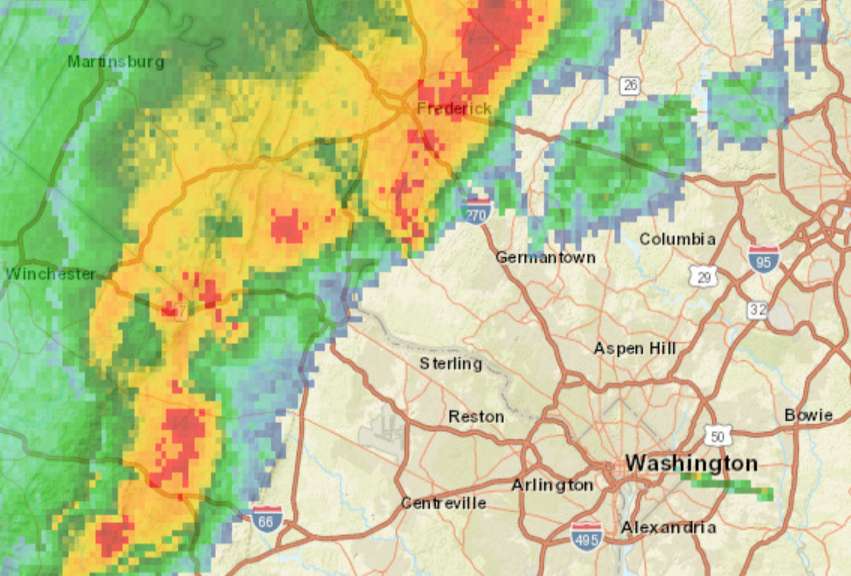
Updated at 5:35 p.m. — The storm has been deemed “destructive” for Clifton, Burke and Annandale, with the National Weather Service warning of “considerable damage to trees and power lines” and that “your life is at significant risk if outdoors.”
Earlier: A storm bringing intense winds and potentially even hail or a tornado is bearing down on the D.C. area.
In anticipation of the weather, the Fairfax County Park Authority closed several outdoor facilities at 4 p.m., including the Water Mine Family Swimmin’ Hole at Lake Fairfax Park in Reston, the Martin Luther King Jr. Pool in Gum Springs and Our Special Harbor Spray Park in Groveton.
All golf courses and driving ranges, marinas and park amusements, like carousels, have also been shut down. Outdoor classes and activities have either been canceled or moved indoors.
With the line of storms moving eastward, the northwestern part of the county is expected to get hit first. The National Weather Service has issued a Severe Thunderstorm Warning until 5:15 p.m. for that area, including Reston, Herndon and possibly Tysons.
The alert warns of 60 mph wind gusts and quarter-sized hail.
“Damaging winds will cause some trees and large branches to fall,” the NWS said. “This could injure those outdoors, as well as damage homes and vehicles. Roadways may become blocked by downed trees. Localized power outages are possible. Unsecured light objects may become projectiles.”
The storm is expected to arrive during the afternoon rush-hour around 5-7 p.m., prompting local federal government offices and other many workplaces to send employees home early.
Metro is “deploying additional resources to respond to weather-related issues” that may affect its service, activating its Emergency Operations Center.
“Severe delays, disruptions, and detours in Metro bus, rail, and paratransit service are possible due to extremely high winds, road conditions and other hazards,” Metro said in a news release.
Severe Thunderstorm Warning including Centreville VA, Reston VA and Linton Hall VA until 5:15 PM EDT pic.twitter.com/Ai5Wnyfgbu
— NWS Baltimore-Washington (@NWS_BaltWash) August 7, 2023

